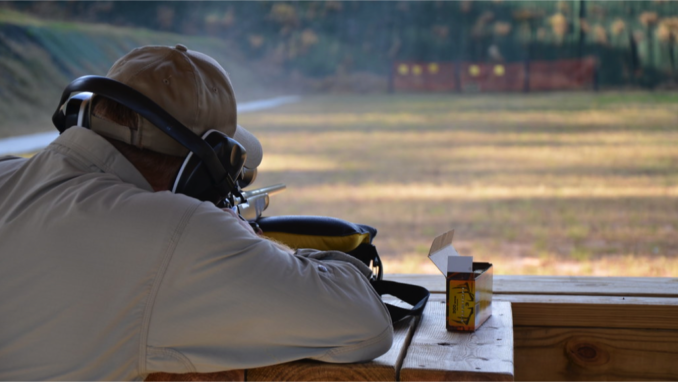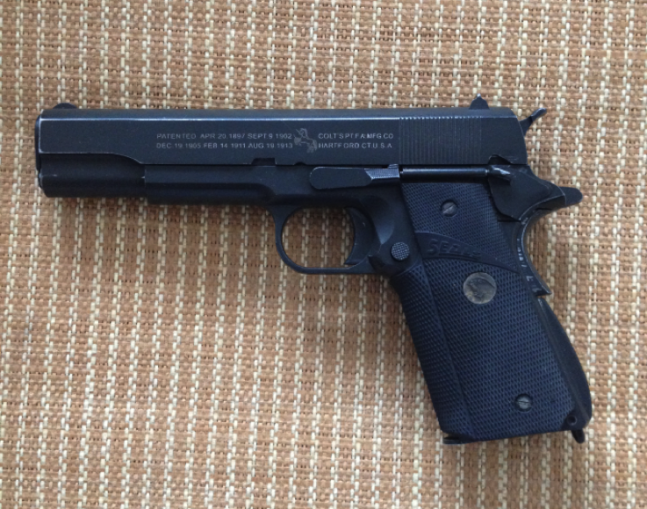
Cedar Creek Shooting Range,
ChattOconeeNF – Licence CC BY-SA 2.0
My father was trained as a sharp shooter, not quite a sniper but somewhere between that and a regular soldier. Exhibiting better than average shooting accuracy with a strong sense of fieldcraft (as he did) is highly valued when attacking enemy forces and especially when used to control a retreat or to prepare an advance. Snipers are a remarkable asset in combat. As I recall he only completed a rather short 2 year course of training but became quite proficient at the task. Funny enough he never saw combat and after the training, he moved sideways into other areas of sport (including boxing) and so that part of his background came to an end.
A distant memory of mine is shooting at a funfair with Dad quietly telling me, “Son, you’ll do better if you shoulder the rifle on your left shoulder”. My puzzled reply being, “Dad, I’m right-handed!”
Some years after he died, I got a hankering to shoot. Partially I wanted to learn new skills but being an optimistic sort, had no grasp of the horror story that is current UK firearms legislation. I was also concerned that the police and government may well be right when they endlessly said it took such a huge amount of training for firearms officers to become proficient… ordinary people like me really couldn’t be expected to master firearms.
Being a cautious chap, I figured it might be worth starting with lower power air rifles at one of the largest air gun clubs in the UK, before even thinking about anything bigger. The licensing restrictions for UK legal air rifles (below 12 ft/lb muzzle energy) are easy to cope with from the point of view of dipping one’s toes into the water and I knew that developing skills in that area would allow me to master safe handling… making it instinctive.
The air gun club was a joy… with a huge group of members all coming from very different backgrounds and all bringing different things to the equation. I loved my time there and made some good friends… both on the engineering side and on the shooting side. I made some mistakes in handling during the first year but the members were always there to help me spot where my handling needed work and to guide me on the best way to tackle solutions. Much of their advice stays with me to this day and I’m grateful to each and everyone who helped. I think they also warmed to someone who was obviously keen to take advice.
One of the many things I learned about myself is that I am a tad unusual (I enjoy Fridays on GP)… like around 30% of the population I’m right-handed but left eye dominant and so whenever I sight through a scope, I’ll always do better if I use my left eye while shouldering the rifle on my left.
The penny dropped some 30 years later… Dad had spotted my eye dominance long before I even knew what it meant.
Safe handling is a thought process. I believe I’ve grasped it properly but I know that I can always learn more. I also quite like the idea, because the procedures required have a reassuring feel and they encourage you to think of the entirety of the machine being mastered.
At the air gun club, I learned a great deal about how to build UK legal air rifles and tune them to make them more accurate than manufacturers generally ever will. For those armed with SGC’s or FAC’s (note that they are certificates, they are NOT licences) – don’t ever look down your nose at air gunners… because they are forced to do more with less and they demand accuracy that full bore shooters can only dream of.
On the range – once you get to the point where you build a degree of proficiency, you’ll notice what other people are doing and if required, you’ll step in to help. Two new folks appear on the range and both are shooting downrange when one suffers a jam and turns the gun to the other asking for help. At that precise moment, if focus is lost on the danger a loaded gun presents while the owner concentrates on the problem of the jam (rather than where the muzzle is pointing) risk elevates real quick.
There are other less dangerous issues concerning good handling. My preferred air rifle is known as a pre-charged pneumatic or PCP, but on my fourth visit to the club, I was shooting a different type known as a Springer rifle. After firing, I’d break the barrel downwards in order to expose the pellet port and compress the spring. Pop in a pellet, straighten and lock the barrel and you’re good for the next shot… however when the barrel is broken and the spring has been fully compressed care is required due to the amount of stored energy in the spring. Back on the range, I’d just broken the barrel, fully compressed the spring and was about to load a new pellet into the breech when a halt was called to firing by one of the members. Knowing they’d all wait patiently until everyone calls clear I put the springer rifle down on the bench (with the barrel still broken) and no pellet in the breech. I was all ready to call clear when the rather helpful chap on my right intervened to show me how to hold the broken barrel on the rifle while at the same time depressing the trigger so that I could release all the spring tension before putting the rifle down on the bench. At that point, the gun was properly safe as there was no pellet in the breech and the spring was fully decompressed. I called clear and the range area was entered safely.
You learn by doing… but the hardware you are using also adds a dimension to your understanding of what is safe and what isn’t. Sometimes you need a little help from folks who have walked the same path. Many thanks Paul O’D – I hope life finds you well.
In the States, a particularly good range fail example can be seen in this video involving an instructor and a student preoccupied with a fault in a laser sight on his semi-auto handgun… seemingly oblivious to the fact that the firearm was ready to fire (whenever the trigger was pulled) the instructor (who I sincerely hope was sacked) appears oblivious to the risk…
The instructor…
- Fails to make the gun safe before forcing the student to take it off the firing line to deal with the separate laser problem.
- Fails to stop the student rotating the gun and pointing it randomly (at his hand and elsewhere) while cocked and ready to fire.
and after the gun has discharged into the student’s hand and has been thrown down onto the range table by the student, the instructor goes on to fail to make it safe… which means that while he is preoccupied dealing with the casualty idiot, the range table has a fully loaded cocked and ready to fire handgun sitting unattended.
It is a catastrophe of bad handling and an object lesson in what not to do.
Thankfully no one else was hurt.
This type of event is known as a negligent discharge (ND).
ND’s are always a problem of poor handling, poor discipline and/or poor practice and every ND is avoidable, regardless of what anyone says to the contrary.
Anecdotally I know people who train SO19 officers. Although a quite secretive bunch, they always comment on how bad the quality of police required to carry arms is… and that the number of shot hands and feet from ND’s is alarmingly high. They have theories as to why this is, but one common theory I have heard is essentially that “plod don’t like guns”. Plod are either told to carry or they carry because it increases their pay and so unlike a passionate and dedicated shooting enthusiast, they don’t go that extra mile!
By the time I had around 3 years of membership of the air gun club under my belt I knew that I could try my first range time in the USA without running into too many problems.
When you visit the States and have a valid passport and cash, you can get access to a range. Pop along, say hi to the range staff and explain you’re a Brit with a knowledge (even if just on paper) of the type of handguns you would like to try… you’d be surprised how friendly they will be.
Most ranges will want to see you demonstrate an understanding of firearm operation and in particular how to make a gun safe before allowing you to shoot. Ranges in Florida often require you to attend a short 30 min safety briefing before shooting. In Virginia, before I was allowed in, they popped an inert training gun (which looked a bit like a Glock 17) down on the table in front of me and asked me to make it safe. The gun had a magazine fitted and it took no more than 4 seconds to do this.
I spoke to the staff afterwards and they said they are looking for two things – deportment or state of mind and ability.
I used the following steps:-
- Before picking up the gun I asked the instructor where is the safe zone in this theoretical test… in other words I sought his agreement of where an imaginary safe backstop would be. He said straight ahead (and briefly cracked a smile).
- I picked up the handgun with my right hand… my index finger outside the trigger guard and resting alongside the frame – muzzle pointing towards the safe backstop. I made sure he could see that my finger was outside the trigger guard.
- I pressed the magazine release button with my thumb to drop the magazine and remove it from the gun.
- I racked the slide with my left hand to remove any cartridge that may have been in the barrel (a dummy round ejected at that point and fell onto the ground).
- While holding the slide back, I lifted the slide lock tab with my thumb to make sure the slide stayed in the locked and open position. I let go of the slide with my left hand and it remained locked in the open position.
- I visually checked the gun was safe by looking through the ejector port into the loading crown of the barrel to make sure it was clear
- I put the gun down on the table with the muzzle towards the agreed safe backstop and the ejector port up… so that the range. inspector could visually confirm to his own satisfaction that the gun was safe.
- Lastly, I picked up the dropped (dummy) round and handed it to the range inspector.
You’ll note it is a controlled process, carried out while the muzzle is always pointing in a safe direction and without making any assumptions about what state the gun is in when brought to the table. It isn’t rushed and it isn’t rehearsed based on the gun because all guns are slightly different – but the basics of how semi-automatic guns work is essentially standard.
No need to rush, it only takes around 4 or 5 seconds to complete.
Does that sound like overkill… after all, this is a dummy gun, why can’t we take shortcuts?

M1911,
Rock_com_cn – Licence CC BY-SA 3.0
The following happened to my niece.
Picture the scene… a party in the States with lots of young folks (20 to 30 years of age) and plenty of booze. The host pulls out a beautiful M1911 pistol complete with magazine and the slide in battery. The host is well proud of this pistol with family links that date right back to WWII.
He waves it around a bit and then plonks it on the table. At that precise moment there is zero risk, because a gun is an inanimate object and will never fire on its own. The risk only sharply elevates if someone picks up the gun… at which point it will be in one of four different states (for now, I’m going to ignore the rather elegant M1911 safeties and I’m also going to ignore the subtle differences between hammer and striker fire guns, should you be confronted by a similar situation involving a Glock).
- The magazine could be empty and no round chambered in the barrel in which case the gun is safe but you can’t know that it is safe by looking at it.
- The magazine could be filled with rounds, but no round chambered in the barrel in which case the gun is safe but you can’t know it is safe by looking at it.
- The magazine could be empty but a single round could be chambered in the barrel in which case the gun is not safe and you won’t know the gun isn’t safe.
- The magazine could be filled with rounds and a round could be chambered in the barrel in which case the gun won’t be safe and you won’t know that it isn’t safe.
The bottom line is that without handling the weapon, you can’t know which of the four states it is in… and so a suitable procedure with any semi-auto is simply remove the magazine from the gun, rack the slide to eject any round in the barrel and then lock the slide back so that anyone coming after you can visually inspect the barrels loading crown to know that it is safe, all done while your trigger finger is outside the trigger guard and the muzzle is pointed somewhere safe.
Personally, I’d have asked the host if I could make it safe rather than just leave it on the table – and that is precisely what my niece asked… and then did. It turned out the magazine was empty and a round wasn’t chambered… so from the get-go, the gun was safe… not that anyone knew.
Part II to follow – range time in the USA
© Verax Cincinnatus 2020
The Goodnight Vienna Audio file
Audio Player



